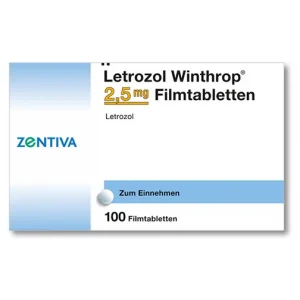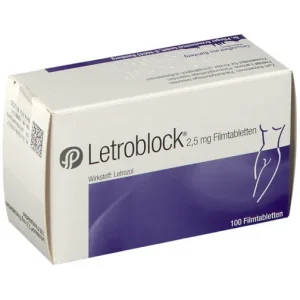Description
Pharmacokinetics
Letrozole is rapidly and completely absorbed from the gastrointestinal tract, with an average bioavailability of 99.9%. Ingestion of food slightly reduces the rate of absorption. The mean time to peak letrozole blood concentration (Tmax) is 1 h for fasting letrozole and 2 h for food intake; the mean peak concentration (Cmax) is 129 ± 20.3 nmol/l for fasting and 98.7 ± 18.6 nmol/l for food intake, but the extent of letrozole absorption (assessed by the area under the concentration-time curve (AUC)) does not change. Small changes in the rate of absorption are not considered to be clinically relevant and letrozole can therefore be taken independent of meals. The binding of letrozole to plasma proteins is approximately 60% (mainly albumin – 55%). The concentration of letrozole in erythrocytes is approximately 80% of the plasma concentration. The apparent volume of distribution at equilibrium is approximately 1.87 ± 0.47 l/kg. Concentration at equilibrium is reached within 2-6 weeks after a daily dose of 2.5 mg. Pharmacokinetics is non-linear. No accumulation has been reported with long-term use.
Letrozole is extensively metabolised under the influence of the CYP3A4 and CYP2A6 cytochrome P450 isoenzymes with the formation of the pharmacologically inactive compound carbinol. Excreted mainly via the kidneys as metabolites, to a lesser extent via the intestines. The final half-life (T1/2) is 48 h.
The pharmacokinetic parameters of letrozole do not depend on the age of the patient.
In renal failure, pharmacokinetic parameters do not change.
In moderate hepatic impairment (Child-Pugh B), mean AUC values, although 37% higher, remain within the range of values observed in subjects without hepatic impairment. In patients with cirrhosis and severe hepatic impairment (Child Pugh C), the AUC increases by 95% and T1/2 by 187%. However, given the good tolerability of high doses of the drug (5-10 mg/day) in these cases, there is no need to change the dose of letrozole.






Reviews
There are no reviews yet.